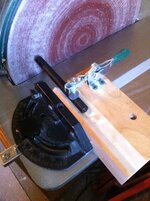So up to this point I have been using a 3/4" Barrel Trimmer head and pivot shaft. It's an okay method but the pivot shaft can be annoying sometimes.
I saw this photo of a guy using a countersink drill bit to square his blanks and it comes out perfectly.
http://www.penturningtips.com/wp-content/uploads/2010/10/IMG_3542-300x225.jpg
My question is, is this a good method for squaring pen blanks? If so, could you tell me a good countersink bit for pen blanks. If not, how do you square your pen blank?
Thanks!!
I saw this photo of a guy using a countersink drill bit to square his blanks and it comes out perfectly.
http://www.penturningtips.com/wp-content/uploads/2010/10/IMG_3542-300x225.jpg
My question is, is this a good method for squaring pen blanks? If so, could you tell me a good countersink bit for pen blanks. If not, how do you square your pen blank?
Thanks!!

